
IDSs are passive elements that are in our network to ensure its security, but what would happen if all our communications were encrypted, or would this protection measure be enough to ensure that my network is protected? These questions and more will be discussed in the following article to provide solutions and advice focused on industrial environments.

The Industrial Internet of Things (IIoT) has experienced considerable growth in recent years, providing crucial improvements. However, it also has some limitations in terms of consumption, security, cost or scalability. In this blog, we will see how the appearance of LoRaWAN in this area can solve part of those limitations.

A high percentage of devices developed for the industrial world have physical interfaces that allow secondary communications to be established. These communications allow the execution of important tasks such as the management of the devices themselves or changing the way they interact with industrial processes. Although in most cases it is necessary to have physical access to the device in order to use these interfaces, manipulation of the device through these interfaces allows attackers to manipulate the operation of the system without leaving any trace if there are no mechanisms to protect the asset from hardware hacking.
This article aims to show the most widespread physical interfaces in industrial devices and embedded systems in general. On the other hand, we want to show some attacks executed throughout history in the industrial world. These attacks, thanks to the physical manipulation of a device, have allowed attackers to achieve a great impact on the targeted industrial process


In the year 2022 and as is reflected in the article “Industrial Security 2022 in numbers”, cyberattacks in all industrial sectors have increased by around 30 % in the third quarter of 2022 and it is estimated that the number of organizations or industrial manufacturers victims of a cyberattack was around 40% in the last year. Especially in the industrial sector, the number of attacks has grown exponentially due to the massive introduction of IoT devices (it is expected to go from 13.5 to 21.5 million connected devices in three years) or more specifically about IIoT devices, which have been the main gateway for attacks as manufacturers have prioritized features and mass-production of devices over the security. In addition, this is compounded by planned obsolescence planned (increasingly present in this type of devices), increased interoperability and connectivity and the appearance of new types of malware and exploits which are much more effective.

This post presents some lines of action that should be followed to deal with a DrDoS cyberattack based on the ARD protocol, describing in detail the prevention, identification and response phases to follow.

In recent years, the concept of machine learning has gained more prominence, mainly driven by advances in parallel computing capacity. More and more developments, applications and programs are using these algorithms to provide systems with greater security, intelligence and independence. However, it’s rarely used in industrial environments, although some recent tests and developments prove its effectiveness, including in the scope of detection and prediction of cyber attacks.

Weaknesses in TCP protocol implementation in middleboxes could provide a means to carry out distributed reflection denial-of-service (DrDoS) attacks against any target.

All organisations must be prepared so that, after the impact of a cyberattack, it may change, improve and adapt its processes and services. For this reason, it is necessary to protect the main business processes using a set of tasks that allow the organisation to evolve after a serious incident to redesign its strategies and minimise the possible impact of future cyberattacks

It is necessary to protect the main business processes through a set of tasks that allow the organisation to recover from a major incident in a timeframe that does not compromise the continuity of its services. This ensures a planned response to any security breach.



